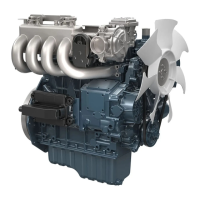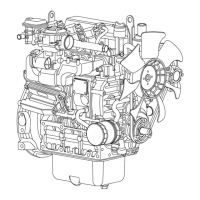9. Stop
the engine and let cool. Check coolant level of
radiator
and
recovery tank (3) and add coolant if
necessary.
Anti-freeze
IMPORTANT
• Make sure that
when you mix the anti-freeze
and water, the ratio of anti-freeze is less than
50 %.
Ratio of
anti-
freeze
Freezing point Boiling point
*
40 % −24 ℃ −11 ℉ 106 ℃ 223 ℉
50 % −37 ℃ −35 ℉ 108 ℃ 226 ℉
* At 1.01 ×
100000 Pa (760 mmHg) pressure
(atmospheric). Use a radiator pressure cap that lets
the pressure collect in the cooling system to get a
higher boiling point.
NOTE
• The above data
is the industrial standards
that shows the minimum glycol content
necessary in the concentrated anti-freeze.
• When the coolant level decreases because
of evaporation, add clean, soft water only to
keep the anti-freeze mixing ratio less than
50 %. If there is a leakage, add anti-freeze
and clean, soft water in the specified mixing
ratio.
• The anti-freeze absorbs moisture. Keep new
anti-freeze in a tightly sealed container.
• Do not use the radiator cleaning agents after
you add anti-freeze to the coolant. anti-
freeze contains an anti-corrosive agent,
which reacts with the radiator cleaning
agent to make sludge and cause damages to
the engine parts.
(A) −0 ℃ (32 ℉)
• There are 2 types of anti-freeze available: use
the permanent type (PT) for this engine.
• When you
add anti-freeze for the first time, flush
the water
jacket and radiator interior with clean,
soft water several times.
• The brand of the anti-freeze and the ambient
temperature have an effect on the procedure to
mix water and anti-freeze. Refer to the SAE
J1034 standard, especially to the SAE J814c.
• Mix the anti-freeze with clean, soft water, and
then fill into the radiator.
3. MAINTENANCE
CHECK AND MAINTENANCE
13. Check points of every 2 years
05-E4B SERIES,05-E4BG SERIES

